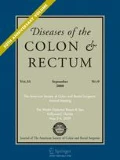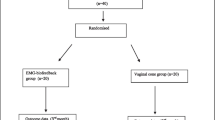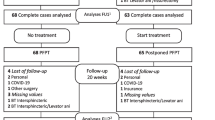Abstract
BACKGROUND: A prospective, three-armed, randomized, controlled trial was performed to assess whether pelvic floor exercises with biofeedback using anal manometry or transanal ultrasound are superior to pelvic floor exercises with feedback from digital examination alone in terms of continence, quality of life, physiologic sphincter strength, and compliance. Its secondary objectives were to assess whether there are any differences in these outcomes between biofeedback with transanal ultrasound vs. anal manometry and to correlate the physiologic measures with clinical outcome. METHODS: One hundred twenty patients with mild to moderate fecal incontinence were randomized into one of three treatment groups: biofeedback with anal manometry, biofeedback with transanal ultrasound, or pelvic floor exercises with feedback from digital examination alone. Commencing one week after an initial 45-minute assessment session, patients attended monthly treatments for a total of five sessions. Each session lasted 30 minutes and involved sphincter exercises with biofeedback that involved instrumentation or digital examination alone, and patients were encouraged to perform identical exercises twice per day between outpatient visits. RESULTS: One hundred two patients (85 percent) completed the four-month treatment program. Across all treatment allocations, patients experienced modest but highly significant improvements in all nine outcome measures during treatment, with 70 percent of all patients perceiving improvement in symptom severity and 69 percent of patients reporting improved quality of life. With the possible exception of isotonic fatigue time, there were no significant differences between the three treatment groups in compliance, physiologic sphincter strength, and clinical or quality-of-life measures. Correlations between physiologic measures and clinical outcomes were much stronger with ultrasound-based measures than with manometry. CONCLUSIONS: Although patients in this study who completed pelvic floor exercises with feedback from digital examination achieved no additional benefit from biofeedback and measurement with transanal ultrasound or manometry, it may be that the guidance received through digital examination alone offered patients in the pelvic floor exercise group an effective biofeedback mechanism. Contrary to our hypothesis, the use of transanal ultrasound offered no benefit over manometry, but the use of ultrasound for isotonic fatigue time and isometric fatigue contractions provided potentially important physiologic measures that require further study. This study has confirmed, through a large sample of patients, that pelvic floor retraining programs are an effective treatment for improving physiologic, clinical, and quality-of-life parameters in the short term.
Similar content being viewed by others
References
A Mellgren LL Jensen JP Zetterstrom WD Wong JH Hofmeister AC Lowry (1999) ArticleTitleLong-term cost of fecal incontinence secondary to obstetric injuries Dis Colon Rectum 42 857–867
MM Fynes K Marshall M Cassidy et al. (1999) ArticleTitleA prospective, randomized study comparing the effect of augmented biofeedback with sensory biofeedback alone on fecal incontinence after obstetric trauma Dis Colon Rectum 42 753–761
ZR Cooper S Rose (2000) ArticleTitleFecal incontinence Mt Sinai J Med 67 96–105
C Mavrantonis SD Wexner (1998) ArticleTitleA clinical approach to fecal incontinence J Clin Gastroenterol 27 108–121
EE Soffer T Hull (2000) ArticleTitleFecal incontinence Am J Gastroenterol 95 1873–1880
InstitutionalAuthorNameThe National Nursing Home Survey (1979) ArticleTitleThe National Nursing Home Survey 1977 summary for the United States Vital Health Stat 13 1–213
JF Johanson J Lafferty (1996) ArticleTitleEpidemiology of fecal incontinence Am J Gastroenterol 91 33–36
CJ Lahr (1988) ArticleTitleEvaluation and treatment of incontinence Practical Gastroenterol 12 27–35
MJ Borrie HA Davidson (1992) ArticleTitleIncontinence in institutions CMAJ 147 322–328
AH Sultan MA Kamm CN Hudson JM Thomas CI Bartram (1993) ArticleTitleAnal-sphincter disruption during vaginal delivery N Engl J Med 329 1905–1911
RE Allen GL Hosker AR Smith DW Warrell (1990) ArticleTitlePelvic floor damage and childbirth Br J Obstet Gynaecol 97 770–779
MJ Solomon J Rex AA Eyers P Stewart R Roberts (2000) ArticleTitleBiofeedback for fecal incontinence using transanal ultrasonography Dis Colon Rectum 43 788–792
AK Ryn GL Morren O Hallbook R Sjodahl (2000) ArticleTitleLong-term results of electromyographic biofeedback training for fecal incontinence Dis Colon Rectum 43 1262–1266
C Norton MA Kamm (1999) ArticleTitleOutcome of biofeedback for faecal incontinence Br J Surg 86 1159–1163
J Girona E Berg I Bross (1997) ArticleTitleBiofeedback [in German] Langenbecks Arch Chir Suppl Kongressbd 114 921–923
CY Ko J Tong RE Lehman AA Shelton TR Schrock ML Welton (1997) ArticleTitleBiofeedback is effective therapy for fecal incontinence and constipation Arch Surg 132 829–833
PW Marcello RC Barrett JA Coller et al. (1998) ArticleTitleFatigue rate index as a new measurement of external sphincter function Dis Colon Rectum 41 336–343
P Enck G Daublin HJ Lubke G Strohmeyer (1994) ArticleTitleLong-term efficacy of biofeedback training for fecal incontinence Dis Colon Rectum 37 997–1001
P Enck (1993) ArticleTitleBiofeedback training in disordered defecation Dig Dis Sci 38 1953–1960
BT Engel P Nikoomanesh MM Schuster (1974) ArticleTitleOperant conditioning of rectosphincteric responses in the treatment of fecal incontinence N Engl J Med 290 646–649
PB Miner TC Donnelly NW Read (1990) ArticleTitleInvestigation of mode of action of biofeedback in treatment of fecal incontinence Dig Dis Sci 35 1291–1298
V Loening-Baucke (1990) ArticleTitleEfficacy of biofeedback training in improving faecal incontinence and anorectal physiologic function Gut 31 1395–1402
SK Patankar A Ferrara JR Levy SW Larach PR Williamson SE Perozo (1997) ArticleTitleBiofeedback in colorectal practice Dis Colon Rectum 40 827–831
WE Whitehead KL Burgio BT Engel (1985) ArticleTitleBiofeedback treatment of fecal incontinence in geriatric patients J Am Geriatr Soc 33 320–324
AM Leroi MP Dorival MF Lecouturier et al. (1999) ArticleTitlePudendal neuropathy and severity of incontinence but not presence of an anal sphincter defect may determine the response to biofeedback therapy in fecal incontinence Dis Colon Rectum 42 762–769
YP Sangwan JA Coller RC Barrett PL Roberts JJ Murray DJ Schoetz SuffixJr (1995) ArticleTitleCan manometric parameters predict response to biofeedback therapy in fecal incontinence? Dis Colon Rectum 38 1021–1025
PJ Lunniss MA Kamm RK Phillips (1994) ArticleTitleFactors affecting continence after surgery for anal fistula Br J Surg 81 1382–1385
M Pescatori G Anastasio C Bottini A Mentasti (1992) ArticleTitleNew grading and scoring for anal incontinence Dis Colon Rectum 35 482–487
W Tillinger C Mittermaier H Lochs G Moser (1999) ArticleTitleHealth-related quality of life in patients with Crohn’s disease Dig Dis Sci 44 932–938
MJ Solomon RS McLeod EK Cohen Z Cohen (1995) ArticleTitleAnal wall thickness under normal and inflammatory conditions of the anorectum as determined by endoluminal ultrasonography Am J Gastroenterol 90 574–578
A Glia M Gylin JE Akerlund U Lindfors G Lindberg (1998) ArticleTitleBiofeedback training in patients with fecal incontinence Dis Colon Rectum 41 359–364
PW Marcello RC Barrett JA Coller et al. (1998) ArticleTitleFatigue rate index as a new measurement of external sphincter function Dis Colon Rectum 41 336–343
SS Rao RS Patel (1997) ArticleTitleHow useful are manometric tests of anorectal function in the management of defecation disorders? Am J Gastroenterol 92 469–475
WF van Tets JH Kuijpers G Bleijenberg (1996) ArticleTitleBiofeedback treatment is ineffective in neurogenic fecal incontinence Dis Colon Rectum 39 992–994
J Hill RJ Corson H Brandon J Redford EB Faragher ES Kiff (1994) ArticleTitleHistory and examination in the assessment of patients with idiopathic fecal incontinence Dis Colon Rectum 37 473–477
E Buch R Alos A Solana JV Roig C Fernandez F Diaz (1998) ArticleTitleCan digital examination substitute anorectal manometry for the evaluation of anal canal pressures? Rev Esp Enferm Dig 90 85–93
Author information
Authors and Affiliations
About this article
Cite this article
Solomon, M.J., Pager, C.K., Rex, J. et al. Randomized, Controlled Trial of Biofeedback With Anal Manometry, Transanal Ultrasound, or Pelvic Floor Retraining With Digital Guidance Alone in the Treatment of Mild to Moderate Fecal Incontinence. Dis Colon Rectum 46, 703–710 (2003). https://doi.org/10.1007/s10350-004-6643-9
Issue Date:
DOI: https://doi.org/10.1007/s10350-004-6643-9




